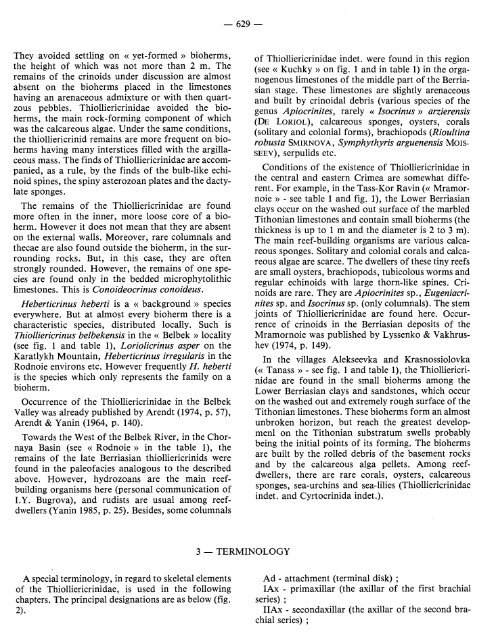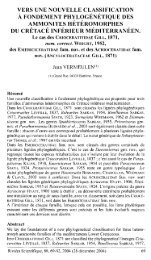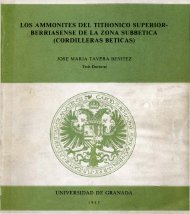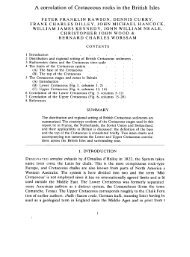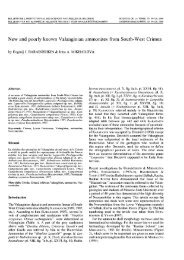thiolliericrinid crinoids from the lower cretaceous of crimea
thiolliericrinid crinoids from the lower cretaceous of crimea
thiolliericrinid crinoids from the lower cretaceous of crimea
Create successful ePaper yourself
Turn your PDF publications into a flip-book with our unique Google optimized e-Paper software.
— 629 —They avoided settling on « yet-formed » bioherms,<strong>the</strong> height <strong>of</strong> which was not more than 2 m. Theremains <strong>of</strong> <strong>the</strong> <strong>crinoids</strong> under discussion are almostabsent on <strong>the</strong> bioherms placed in <strong>the</strong> limestoneshaving an arenaceous admixture or with <strong>the</strong>n quartzouspebbles. Thiolliericrinidae avoided <strong>the</strong> bioherms,<strong>the</strong> main rock-forming component <strong>of</strong> whichwas <strong>the</strong> calcareous algae. Under <strong>the</strong> same conditions,<strong>the</strong> <strong>thiolliericrinid</strong> remains are more frequent on biohermshaving many interstices filled with <strong>the</strong> argillaceousmass. The finds <strong>of</strong> Thiolliericrinidae are accompanied,as a rule, by <strong>the</strong> finds <strong>of</strong> <strong>the</strong> bulb-like echinoidspines, <strong>the</strong> spiny asterozoan plates and <strong>the</strong> dactylatesponges.The remains <strong>of</strong> <strong>the</strong> Thiolliericrinidae are foundmore <strong>of</strong>ten in <strong>the</strong> inner, more loose core <strong>of</strong> a bioherm.However it does not mean that <strong>the</strong>y are absenton <strong>the</strong> external walls. Moreover, rare columnals and<strong>the</strong>cae are also found outside <strong>the</strong> bioherm, in <strong>the</strong> surroundingrocks. But, in this case, <strong>the</strong>y are <strong>of</strong>tenstrongly rounded. However, <strong>the</strong> remains <strong>of</strong> one speciesare found only in <strong>the</strong> bedded microphytolithiclimestones. This is Conoideocrinus conoideus.Heberticrinus heberti is a « background » specieseverywhere. But at almost every bioherm <strong>the</strong>re is acharacteristic species, distributed locally. Such isThiolliericrinus belbekensis in <strong>the</strong> « Belbek » locality(see fig. 1 and table 1), Loriolicrinus asper on <strong>the</strong>Karatlykh M ountain, Heberticrinus irregularis in <strong>the</strong>Rodnoie environs etc. However frequently H. hebertiis <strong>the</strong> species which only represents <strong>the</strong> family on abioherm.Occurrence <strong>of</strong> <strong>the</strong> Thiolliericrinidae in <strong>the</strong> BelbekValley was already published by Arendt (1974, p. 57),Arendt & Yanin (1964, p. 140).Towards <strong>the</strong> West <strong>of</strong> <strong>the</strong> Belbek River, in <strong>the</strong> ChornayaBasin (see « Rodnoie » in <strong>the</strong> table 1), <strong>the</strong>remains <strong>of</strong> <strong>the</strong> late Berriasian <strong>thiolliericrinid</strong>s werefound in <strong>the</strong> pale<strong>of</strong>acies analogous to <strong>the</strong> describedabove. However, hydrozoans are <strong>the</strong> main reefbuildingorganisms here (personal communication <strong>of</strong>I.Y. Bugrova), and rudists are usual among reefdwellers(Yanin 1985, p. 25). Besides, some columnals<strong>of</strong> Thiolliericrinidae indet. were found in this region(see « Kuchky » on fig. 1 and in table 1) in <strong>the</strong> organogenouslimestones <strong>of</strong> <strong>the</strong> middle part <strong>of</strong> <strong>the</strong> Berriasianstage. These limestones are slightly arenaceousand built by crinoidal debris (various species <strong>of</strong> <strong>the</strong>genus Apiocrinites, rarely « Isocrinus » arzierensis(De Loriol), calcareous sponges, oysters, corals(solitary and colonial forms), brachiopods (Rioultinarobusta Sm irno va, Symphythyris arguenensis Moisseev),serpulids etc.Conditions <strong>of</strong> <strong>the</strong> existence <strong>of</strong> Thiolliericrinidae in<strong>the</strong> central and eastern Crimea are somewhat different.For example, in <strong>the</strong> Tass-Kor Ravin (« Mramornoie» - see table 1 and fig. 1), <strong>the</strong> Lower Berriasianclays occur on <strong>the</strong> washed out surface <strong>of</strong> <strong>the</strong> marbledTithonian limestones and contain small bioherms (<strong>the</strong>thickness is up to 1 m and <strong>the</strong> diameter is 2 to 3 m).The main reef-building organisms are various calcareoussponges. Solitary and colonial corals and calcareousalgae are scarce. The dwellers <strong>of</strong> <strong>the</strong>se tiny reefsare small oysters, brachiopods, tubicolous worms andregular echinoids with large thorn-like spines. Crinoidsare rare. They же Apiocrinites sp., Eugeniacrinitessp. and Isocrinus sp. (only columnals). The stemjoints <strong>of</strong> Thiolliericrinidae are found here. Occurrence<strong>of</strong> <strong>crinoids</strong> in <strong>the</strong> Berriasian deposits <strong>of</strong> <strong>the</strong>M ramornoie was published by Lyssenko & Vakhrushev(1974, p. 149).In <strong>the</strong> villages Alekseevka and Krasnossiolovka(« Tanass » - see fig. 1 and table 1), <strong>the</strong> Thiolliericrinidaeare found in <strong>the</strong> small bioherms among <strong>the</strong>Lower Berriasian clays and sandstones, which occuron <strong>the</strong> washed out and extremely rough surface <strong>of</strong> <strong>the</strong>Tithonian limestones. These bioherms form an almostunbroken horizon, but reach <strong>the</strong> greatest developmenlon <strong>the</strong> Tithonian substratum swells probablybeing <strong>the</strong> initial points <strong>of</strong> its forming. The biohermsare built by <strong>the</strong> rolled debris <strong>of</strong> <strong>the</strong> basement rocksand by <strong>the</strong> calcareous alga pellets. Among reefdwellers,<strong>the</strong>re are rare corals, oysters, calcareoussponges, sea-urchins and sea-lilies (Thiolliericrinidaeindet. and Cyrtocrinida indet.).3 — TERMINOLOGYA special terminology, in regard to skeletal elements<strong>of</strong> <strong>the</strong> Thiolliericrinidae, is used in <strong>the</strong> followingchapters. The principal designations are as below (fig.2).Ad - attachment (terminal disk) ;lAx - primaxillar (<strong>the</strong> axillar <strong>of</strong> <strong>the</strong> first brachialseries) ;IIAx - secondaxillar (<strong>the</strong> axillar <strong>of</strong> <strong>the</strong> second brachialseries) ;


